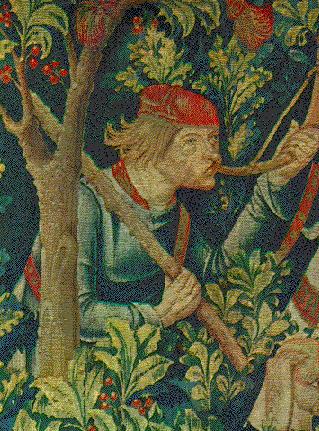|
The Tapestries at the Cloisters
(THE METROPOLITAN MUSEUM OF ART)
The Unicorn Tapestries
By:
Sarah J. Albertini Danielle M. Pastor
()
([email protected])
The myth of the unicorn has
been around since Ancient China and yet still appears in modern
culture--from literature to art to music. What is it that enchants
us with a creature that has never roamed the Earth? We may never
understand our fascination with this mythical beast, but we can
appreciate the artists who try to bring it to life for us.
Much like the unicorn itself,
the famed Unicorn Tapestries at the Cloisters, leave the viewer
with many questions. What we do know is not certain knowledge.
 The
tapestries were thought to have been designed in France and made
in Brussels. Therecipient of these magnificent tapestries are
unknown. Some clues to the identity of this person has been left
behind in the tapestries themselves. Much has been made of the
initials A and a reversed E that are joined together by a bow.
This was an insignia of Anne of Brittany, twice queen of France.
The same theory suggests that in the sixth tapestry, the lovers
who look at each other are Anne and Louis XII. The
tapestries were thought to have been designed in France and made
in Brussels. Therecipient of these magnificent tapestries are
unknown. Some clues to the identity of this person has been left
behind in the tapestries themselves. Much has been made of the
initials A and a reversed E that are joined together by a bow.
This was an insignia of Anne of Brittany, twice queen of France.
The same theory suggests that in the sixth tapestry, the lovers
who look at each other are Anne and Louis XII.
Another equally plausible theory
is that the noble La Rochefoucald family were the original owners.
This is because in the third tapestry, the initials F and R are
sewn into the sky. Also the A and E initials can be linked to
Antoinette of Ambroise, wife of Francois La Rochfoucald.
The theme of the tapestries
is the fight between the unicorn and the humans who peruse it.
The first tapestry, The
Start of the Hunt, introduces us to the hunters but not
the unicorn. The hunters are not dressed for hunting, but rather
in clothing in rich colors and textures.
The second tapestry, The
Unicorn at the Fountain", is where the unicorn uses
his magical horn to remove the snake's venom from the water. It
is here that the theory begins that the unicorn is a symbol of
Jesus Christ. Here the unicorn, Christ, saves all from the snake's
poison, Satan. Even the humans who were hunting the unicorn are
awed by this act.
The third tapestry is The
Unicorn Leaps the Stream. Here the serenity of the second
tapestry is abandoned as one looks at a highly charged action
scene. The hunters now have ugly and cruel faces--symbolizing
the persecutors of Jesus Christ.
 For
the fourth tapestry, The Unicorn Defends Himself,
the unicorn becomes savage, kicking and butting people and animals.
A new comer to the scene, a man with a horn, is thought to symbolize
the archangel Gabriel. For
the fourth tapestry, The Unicorn Defends Himself,
the unicorn becomes savage, kicking and butting people and animals.
A new comer to the scene, a man with a horn, is thought to symbolize
the archangel Gabriel.
Unfortunately, the fifth tapestry, The Unicorn is Captured by the Maiden", is
now in fragments because of mishandling over the years. According
to tradition, the unicorn can only be trapped by a virginal maiden.
The enclosed garden that the two are in, was a medieval symbol
of chastity. Also, the apple tree in the center of the tapestry
has many religious meanings. The most obvious is a reminder of
the Fall of Adam and Eve, hence suggesting that the unicorn, Christ,
and is the Redemption after the Fall.
The sixth tapestry,The
Unicorn is Killed and Brought to the Castle is wrought
with emotion. The overall scene is centered the slain unicorn,
who is bleeding in the upper left hand corner. All in the scene
seem to be awed and shocked by the sight of the slain beast being
brought towards them.
The seventh tapestry, The
Unicorn in Captivity is the most famous of all the Unicorn
Tapestries. The unicorn here is miraculously alive again. In this
tapestry he rests chained to a circular wooden gate. The rise
unicorn is symbolic of the risen Christ. However, since the unicorn
is chained there is some confusion to this symbolism. One theory
is that the unicorn, like Jesus Christ, is linked to life or humanity
forever. The other theory is that the unicorn symbolizes a bridegroom
secured by his lover.
[back to Medieval NewYork]
[Back to Tapestries Main Page]
Site Author: Sarah Albertine and Danielle pastor,
Project for "Introduction to Medieval History", Fordham
University, Spring 1997
The Internet History Sourcebooks Project is located at the History Department of Fordham University, New York. The Internet
Medieval Sourcebook, and other medieval components of the project, are located at
the Fordham University Center
for Medieval Studies.The IHSP recognizes the contribution of Fordham University, the
Fordham University History Department, and the Fordham Center for Medieval Studies in
providing web space and server support for the project. The IHSP is a project independent of Fordham University. Although the IHSP seeks to follow all applicable copyright law, Fordham University is not
the institutional owner, and is not liable as the result of any legal action.
© Site Concept and Design: Paul Halsall created 26 Jan 1996: latest revision 12 April 2024 [CV]
|